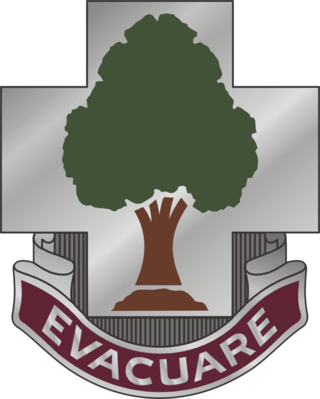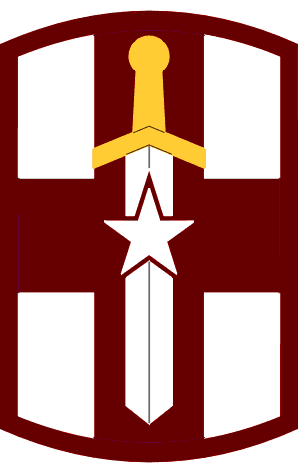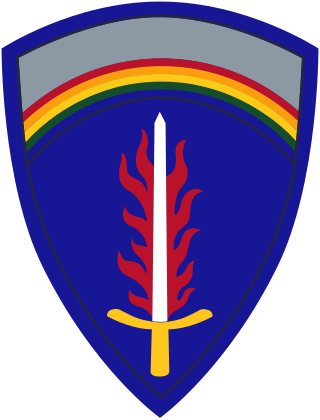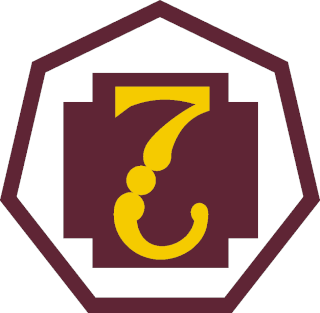
V Corps, formerly known as the Fifth Corps, is a regular corps of the United States Army at Fort Knox. It was previously active during World War I, World War II, the Cold War, the Kosovo War, and the War on Terrorism.

The 63rd Infantry Division was an infantry division of the United States Army that fought in Europe during World War II. After the war it was inactivated, but later the division number and shoulder sleeve insignia were authorized for use by the 63rd Army Reserve Command (ARCOM).

Campbell Barracks, in Heidelberg, Germany, was home to Headquarters, United States Army Europe (USAREUR) from 1948 to 2013. It was also home to Headquarters, V Corps and Headquarters, Allied Force Command Heidelberg.

The 5th Signal Command (Theater) ("Dragon Warriors") was a European-based tactical and strategic communications organization of the United States Army specializing in command and control which supported theater-limited, joint-forces, and combined forces activities. The command's mission was to build, operate and defend network capabilities to enable mission command and create tactical, operational and strategic flexibility for Army, Joint and Multinational forces in the EUCOM and AFRICOM areas of responsibility.

The 56th Artillery Command is a two-star command of the United States Army that serves as the Force Field Artillery Headquarters for U.S. Army Europe and Africa, with a mission to synchronize, integrate, and control fires and effects in support of the theater land component. The unit was originally formed on September 14, 1942, as the 56th Coast Artillery Brigade and has been reorganized and redesignated several times until its inactivation on June 30, 1991, following the reunification of Germany and the end of the Cold War.
Taylor Barracks is a former military installation in the Vogelstang suburb of Mannheim, Germany, operated and administrated by the United States Army, Europe, USAREUR. In Dec 2010 USAREUR announced that the installation was handed back to the German government.

The 115th Field Hospital is a field hospital of the United States Army formed in 1917 and perpetuated until today. The hospital has participated in World War I, World War II, Desert Storm, Operation Iraqi Freedom and Operation Enduring Freedom (Afghanistan). As of March 2019, the 115th Combat Support Hospital reorganized and re-designated as a field hospital and is now a component unit of the 32d Hospital Center.

This article incorporates public domain material from websites or documents of the United States Army.

The 807th Medical Command (Deployment Support) (MC(DS)) is headquartered at Fort Douglas in Salt Lake City, Utah and manages all the Army Reserve deployable field medical units west of Ohio. There are over 11,000 Soldiers that comprise 116 subordinate units in the command. The command is separated into five brigades. While the 3rd MCDS covers the MTOE Reserve medical units to the east and ARMEDCOM provides command and control for all the Table of Distribution and Allowance (TDA) medical units within CONUS.

The 3rd Medical Command (Deployment Support) (MCDS) or "Desert Medics" is headquartered in Atlanta, GA and manages all the Army Reserve deployable field medical units east of Ohio. While the 807th MCDS covers the MTOE medical units to the west and ARMEDCOM provides command and control for all the Table of Distribution and Allowance (TDA) medical units within CONUS.

The 6th Medical Logistics Management Center (6MLMC), a direct reporting unit of U.S. Army Forces Command FORSCOM at Fort Bragg, North Carolina, with administrative control and training readiness authority to the Medical Research and Material Command USAMRMC Fort Detrick, Maryland serves as the Army's only deployable medical materiel management center worldwide.

The 59th Ordnance Brigade is a military unit of the United States Army. The unit is currently stood up as the U.S. Army Ordnance School's training brigade. In its previous iteration, the brigade had more than 6,500 soldiers. It was responsible for storage, delivering, maintaining, Nuclear and Chemical Control Orders, and supervising the weapons of mass destruction for U.S. Forces and Forces of the Allied NATO-Countries, except France.

The 21st Theater Sustainment Command provides theater sustainment throughout EUCOM and AFRICOM Areas of Responsibility in support of USAREUR and 7th Army. On order, deploys to support theater opening, distribution, and Reception, Staging, Onward Movement & enable Integration (RSO&I) functions. Be prepared to support Joint and Coalition forces.

The 21st Field Artillery Regiment is a field artillery regiment of the United States Army first formed in 1916. A parent regiment under the U.S. Army Regimental System, all components of the regiment are currently inactive. The 1st Battalion 21st Field Artillery Regiment, the regiment's final active component, deactivated on June 12, 2014.
The 30th Field Artillery Regiment is a field artillery regiment of the United States Army, first constituted in 1918 in the National Army (USA).

The 58th Infantry Regiment is a regiment of the United States Army first established in 1917.

United States Army Europe and Africa (USAREUR-AF) is an Army Service Component Command (ASCC) /Theater Army responsible for directing United States Army operations throughout the U.S. European Command (EUCOM) and U.S. Africa Command (AFRICOM) area of responsibility.

The 326th Medical Battalion was a divisional support medical unit of the United States Army. It supported the 101st Airborne Division, located at Fort Campbell, Kentucky. Its lineage and honors are perpetuated by the 626th Support Battalion, 101st Airborne Division, Fort Campbell, Kentucky.

The 7th Medical Command provided Echelon/Role 4 Health Service Support to units of the United States Army Europe. It was a Table of organization and equipment organization that replaced the United States Army Medical Command, Europe, a Table of distribution and allowances-based organization that had provided both Role 3 and Role 4 Health Service Support from 1970 to 1978. Upon the inactivation of the 7th Medical Command in 1994, the Role 4 mission was assumed by the United States Army Medical Command through its European Health Service Support Area, while the remaining Role 3 mission was assumed by the 30th Medical Brigade.

The United States Army Medical Command, Vietnam (USAMEDCOMV) provided Echelon/Role 3 Health Service Support to units of the United States Army Vietnam (USARV). It was a Table of Distribution and Allowances organization created by consolidating the staffs of the 44th Medical Brigade and the USARV Surgeon's Office. This action was taken as part of the overall drawdown of forces in Vietnam in an effort to reduce headquarters staffs and increase efficiencies. As the medical footprint further reduced in 1972, it was replaced by the United States Army Health Services Group, Vietnam on 30 April 1972.
























